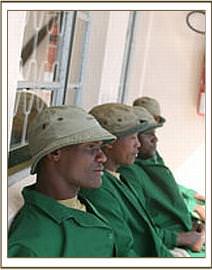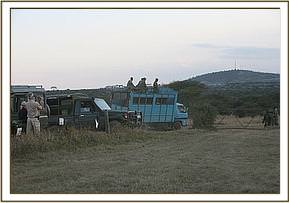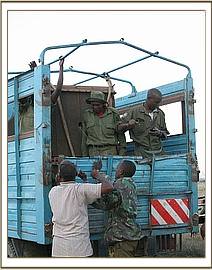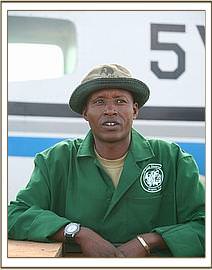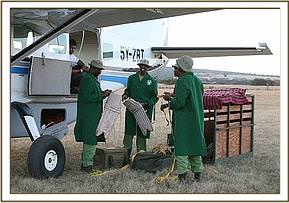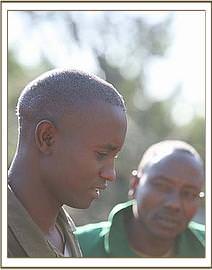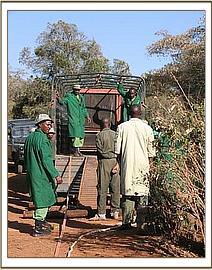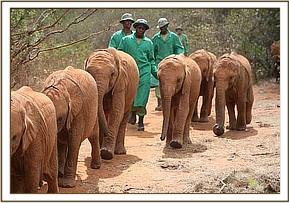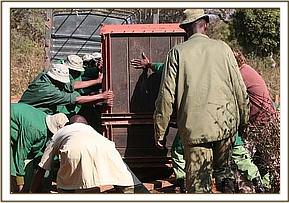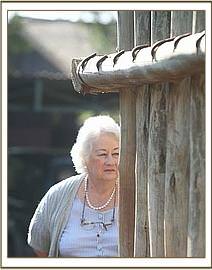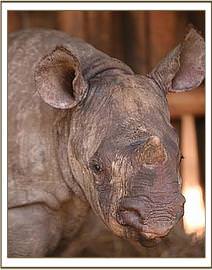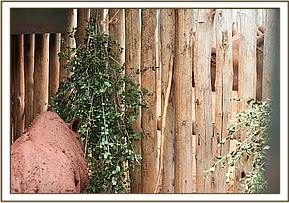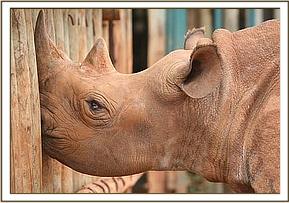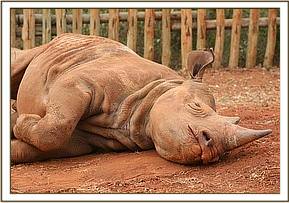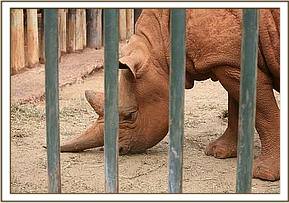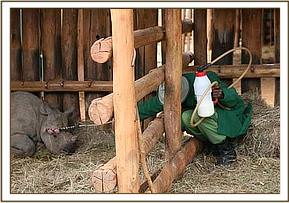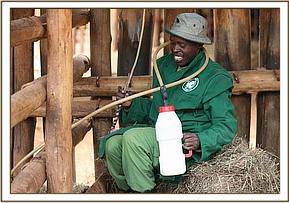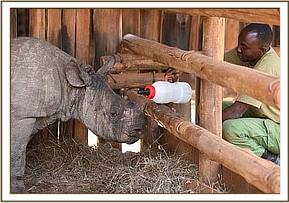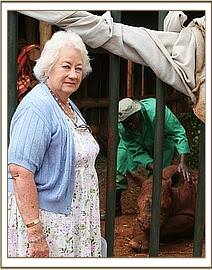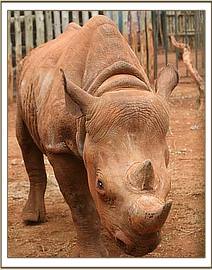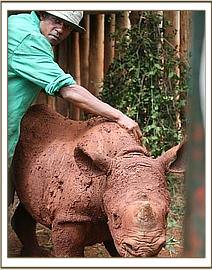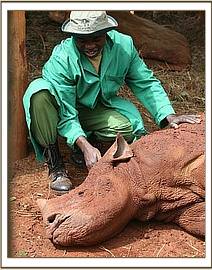











Now living wild in Nairobi National Park, where she is a mother of two wild-born calves
Current age
15 years old
Gender
Female
Rescued date
23 September 2010
Rescue location
Laikipia, Solio Ranch
Date of birth (estimate)
1 April 2010
Reason orphaned
Poaching
Age at rescue
5 months old (approx)
Current location
Living Wild
It is from this Solio population that black rhinos have been reintroduced to other protected areas since the 1980’s. It was also to Solio Ranch that David Sheldrick moved Tsavo East’s orphaned rhino Reudi in the 1960’s, who was continually under attack from other rhinos, and who became the breeding bull of the ranch. Consequently Reudi probably fathered most of the living black rhinos in Kenya today. In 1976, when David was transferred from Tsavo East to head the Planning Unit in Nairobi, two remaining Tsavo black rhino orphans, Stroppie and Pushmi (known as Hoshim) were transferred to Solio Ranch where he knew they would be protected and cared for. They lived in a 50 acre paddock until Stroppie died in 2010 at the ripe old age of 40. (Two years later, in 2012, Pushmi tragically died from a spear wound, he was 38 years old and quite possibly the oldest living black rhino in Kenya).
The rescue alert came to us during the afternoon of 23rd September 2010, at a time when Solio Ranch had recently been targeted by poachers and some of its rhinos had been killed. One such casualty could be the mother of the orphan we rescued that day, her mother rendered immobile from her injuries, however the reason for her injury was not officially confirmed at the time.
Having received the call, we chartered an aircraft, with 4 Keepers aboard plus all the paraphernalia required to overpower and airlift back to the Nursery what we were told was a 5 month old calf. However, when the rescue team arrived, they found that the young rhino was thought to be older than 5 months – possibly closer to a year, and extremely feisty – far too aggressive to risk being transported in a plane. Having already been immobilized to load into a crate, the KWS Vet in attendance did not want to risk another sedation, hence the rescue plane returned empty, leaving two Keepers with the young rhino.
The Keepers had not anticipated spending a freezing night at high altitude, without blankets or food. Angela Sheldrick phoned a friend, Tanya Church, who happens to own the recently built small exclusive Lodge on the Ranch. They came to the rescue, bringing blankets, food and water to the stranded Keepers, who spent an uncomfortable night beside the crated rhino on the Solio Airfield.
Meanwhile, Lewa very kindly provided the truck that would now be needed to move the rhino, and she arrived on our doorstep at 5 am on the morning of the 24th, waking up all the elephants in the Nursery who began bellowing for their milk earlier than usual.
The problem was now how to unload what was an extremely weighty cargo, which actually required a fork lift or a block and tackle. Neither were available locally, so it required the ingenuity and expertise of Robert Carr-Hartley (Angela's husband) to undertake this task and this he did, with the help of tow ropes attached to the crate and pulled in unison by two Land Rovers, with all the Keepers beside the crate to ensure that it remained upright as it was gradually eased down a ramp onto log rollers. This was accomplished successfully, and the next essential task was to inoculate the calf with antibiotics to forestall pneumonia and other ailments brought on by stress due to a resultant depressed immune system. Crouched on top of the crate, and using a pole syringe, Robert managed to inject both the antibiotic, and vitamins.
The rhino calf was extremely strong still, but quite obviously badly in need of both water and sustenance. Thereafter the crate was maneuvered to the dividing entrance to orphan elephant Kandecha’s night stockade, abutting the one set aside for the new rhino, so that the newcomer could be let out into Kandecha’s quarters, and the crate then hauled back through the entrance to its designated stockade.
She came out hesitatingly, and thereafter repeatedly smashed against the sides and door of the stockade, attempting to deal with all in sight. Only the soft exhalation of breath - the sound with which a mother calls its baby, relaxed the calf a little, indicated by the attitude of the ears, but the little rhino was nevertheless still far too aggressive to risk being handled. Once the crate was out of the way, the calf was tempted into its designated stockade and the dividing door between the two stockades closed by remote control, everyone still keeping well out of her way!
The new orphan is a female, and named Solio. She is extremely important to the survival of the species since the demand for rhino horn in the Far East has rapidly driving this ancient species to extinction. Her stockade abuts that of blind rhino Maxwell, who was very interested in the entire procedure, and whose rhino scent helped to provide a calming influence for the calf because she knew she was not alone.
Two Keepers were placed on duty from the outset. A bottle brush strapped onto a long stick seemed to have the desired effect and she could not resist the sensation and would roll over and so it was that Solio was caressed into submission and quickly became totally trusting of the Keepers, and would finally accept her milk bottle and soon became totally tame and able to take long walks into the Park following her men in green. She loved the walks around the dung piles and urinals of Nairobi National Park's wild rhinos, engaging in the reintroduction process early, so that when Solio became old enough to live an independent life the wild rhinos of Nairobi National Park were ready to tolerate her presence. She loved her walks and the mudbath and dustbaths and of course she grew close to Maxwell as well, who lived in the adjacent large compound boma. The safety of his wooden boma dividing them, because despite being desperately interested in each other with rhinos a fight is never far away!
[Update 2019] Solio has been living an independent and wild life in Nairobi National Park, having reintegrated into the population some years earlier. Her reintegration has been such as success that in September 2019 she gave birth to her first calf, having mated with a dominant bull, and we could not be more proud to see her with her tiny baby in tow, having worked so hard to rescue her in 2010 and then care for over the subsequent years so that she could enjoy a full life in the wild, after her traumatic beginnings.
It is from this Solio population that black rhinos have been reintroduced to other protected areas since the 1980’s. It was also to Solio Ranch that David Sheldrick moved Tsavo East’s orphaned rhino Reudi in the 1960’s, who was continually under attack from other rhinos, and who became the breeding bull of the ranch. Consequently Reudi probably fathered most of the living black rhinos in Kenya today. In 1976, when David was transferred from Tsavo East to head the Planning Unit in Nairobi, two remaining Tsavo black rhino orphans, Stroppie and Pushmi (known as Hoshim) were transferred to Solio Ranch where he knew they would be protected and cared for. They lived in a 50 acre paddock until Stroppie died in 2010 at the ripe old age of 40. (Two years later, in 2012, Pushmi tragically died from a spear wound, he was 38 years old and quite possibly the oldest living black rhino in Kenya).
The rescue alert came to us during the afternoon of 23rd September 2010, at a time when Solio Ranch had recently been targeted by poachers and some of its rhinos had been killed. One such casualty could be the mother of the orphan we rescued that day, her mother rendered immobile from her injuries, however the reason for her injury was not officially confirmed at the time.

View diary updates from across all our orphan units as written by the Keepers

Kenya is rewriting its rhino story — and we are proud of the role we play in it.
Sultan is the first calf of wild living black rhino Solio, who was raised at our Nursery after being orphaned as an infant in 2010. Sultan was first sighted by the KWS Rhino Monitoring team on 5th September 2019, at just three days old, in Nairobi National Park and mum has been keeping him close ever since. Read more
On 31st January 2022, the KWS Rhino Monitoring Unit, in Nairobi National Park, spotted Solio with a newborn calf by her side. She had given birth to a baby girl just the day before, who has been named Savannah. Savannah has an older brother in Sultan, Solio's first calf born in 2019. He's rapidly growing in independence, but has been spotted hanging out with his mum and little sister. Read more
By adopting, you play a vital role in the life of an orphaned elephant, rhino, or giraffe — helping us provide the round-the-clock, loving attention each one needs and deserves over many years, so they can ultimately reclaim their place in the wild.
Your adoption supports the 100+ orphans in our care at any given time, covering the cost of milk and food supplies, Keepers' salaries, veterinary treatment, and other essentials.

Celebrate your adoption with a personalised certificate, ready for you or your lucky gift recipient to print and display!

Each month, we send a detailed update about our Orphans’ Project direct to your email inbox, featuring photos, stories, and special highlights.

From the latest Keepers’ Diaries to a downloadable image gallery and more, adopters have exclusive access to our content library.
